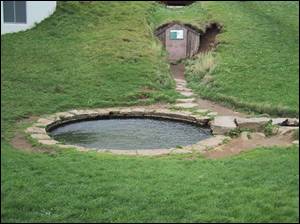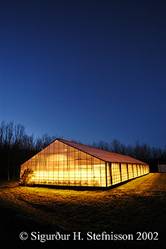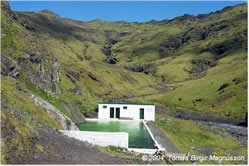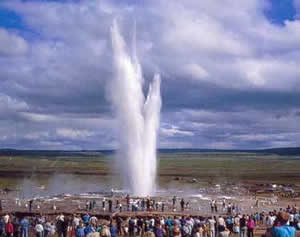Geothermal Energy
How GE is used in Iceland
Steam Power in Iceland
High and Low Temp Fields
Icelandic Spaas
Thermal Waters of Hungary
Geothermal Energy
Geothermal Energy in Hungary
Spas in Budapest
Spas in Hungary
How GE is used in Iceland
Steam Power in Iceland
High and Low Temp Fields
Icelandic Spaas
Thermal Waters of Hungary
Geothermal Energy
Geothermal Energy in Hungary
Spas in Budapest
Spas in Hungary
In the following text we are going to tell you a little bit of how the Icelandic people have used the famous geothermal energy through the years and also how it is used today.

The Icelandic geothermal energy has been used for many years for multiple purposes. Ever since the first permanent settler, Ingólfur Arnarsson, came to Iceland, people have figured out many ways to use the geothermal energy. For example when he came to Reykjavík, he saw smoke rising from the geothermal zones which are in Laugardalur in Reykjavík. That is the reason for why Icelanders usually translate Reykjavík to “Smoky Bay”. In the early 20th century and before that the women in Reykjavík all went there to wash their and their families’ clothes.
The very famous Icelandic poet, Snorri Sturluson, who lived in Western Iceland some 800 years ago, had a round pool, which he used to bathe in and get inspiration. That pool was called “Snorralaug”. Snorri wasn't the only poet to use a pool of that kind. Another poet called Egill Skallagrímsson, who lived in Western Iceland some 1100 years ago, was made exile and went to Drangey, an island in the north of the country. Some time after that, he swam to shore, at least 10 km and heated himself up in a pool of a similar kind.
Before the Icelandic people realized how much the geothermal energy was useful, the saying: “Túninu spillir jarðhitinn” or “The geothermal heat spoils the hayfield”. That was because there could sometimes form hot springs in the middle of some hayfields in the southwest of Iceland, but the farmers didn't like it.
 Geothermal energy has also been used for many other purposes. The people in Hveragerði, in Southwest Iceland use it for heating their greenhouses. In Hveragerði, there are a lot of these greenhouses and when you are driving there from Reykjavík you have drive down a mountain and it can be spectacular to see the greenhouses lit up in the dark nights in the winter.
Geothermal energy has also been used for many other purposes. The people in Hveragerði, in Southwest Iceland use it for heating their greenhouses. In Hveragerði, there are a lot of these greenhouses and when you are driving there from Reykjavík you have drive down a mountain and it can be spectacular to see the greenhouses lit up in the dark nights in the winter.
The first experiments to use geothermal energy for house heating were made in the middle of the 18th century and for many years; Icelanders have used it to heat their houses. The steam from the hot water is used to heat up ground wat er which all dissolved oxygen and other gases have been removed from. That water is pumped into pipes which go into peoples houses and heat them up.
er which all dissolved oxygen and other gases have been removed from. That water is pumped into pipes which go into peoples houses and heat them up.
The geothermal heat is also used for many other things. For example to heat swimming pools such as this one to the right, which is in a very remote part of South Iceland. As you can see, it is very natural.
Geothermal heat is also used by many companies to dry some products, like fish heads and wood. The heat is also used for some other things for example to bake bread and heat up footpaths, streets and parking places.
 The Icelandic geothermal energy is known worldwide and especially for the geysers. The word “geyser” is actually an Icelandic word. The most famous geyser in Iceland is called Geysir and that name is what all other geysers are named after, like Old Faithful in Yellowstone national park in the USA.
The Icelandic geothermal energy is known worldwide and especially for the geysers. The word “geyser” is actually an Icelandic word. The most famous geyser in Iceland is called Geysir and that name is what all other geysers are named after, like Old Faithful in Yellowstone national park in the USA.
Geysir, and the neighboring zone, has been active for over 10.000 years or since the last ice age, but it changes every day. In 1294, a huge earthquake shook the earth and everything changed a lot. In 1590, the geysers stopped erupting but forty years later, another earthquake shook the earth and they began to erupt again. Geysir is believed to have shot water up to heights up to 80-100 meters in that time.
When the last large earthquake happened on the Independence Day of Iceland, June 17th in the year 2000, Geysir began to erupt after a long break, but the eruptions are lower and less regular than in the old days. Strokkur, Geysirs sidekick, has been erupting every 5-10 minutes for the last 40 years. Its eruptions don’t get even close to what Geysir used to do in the old days or can get up to 30 meters.